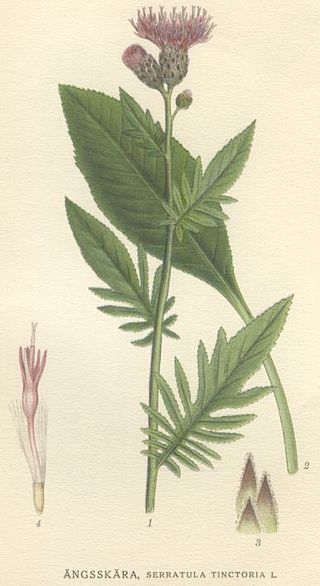
Alcea is a genus of over 80 species of flowering plants in the mallow family Malvaceae, commonly known as the hollyhocks. They are native to Asia and Europe. The single species of hollyhock from the Americas, the streambank wild hollyhock, belongs to a different genus.

The Cardueae are a tribe of flowering plants in the daisy family (Asteraceae) and the subfamily Carduoideae. Most of them are commonly known as thistles; four of the best known genera are Carduus, Cynara, Cirsium, and Onopordum.

Serratula is a genus of plants in the tribe Cardueae within the family Asteraceae native to Eurasia. Plumeless saw-wort is a common name for plants in this genus. Serratula as traditionally defined contains at least two groups: one of which is basal within the subtribe Centaureinae and one of which is derived; the former group can be moved to the genus Klasea.

Vladimir Leontyevich Komarov was a Russian and Soviet botanist.

Quercus mongolica, commonly known as Mongolian oak, is a species of oak native to Japan, China, Korea, Mongolia, and Siberia. The species can grow to be 30 metres tall.

Jurinea is a genus of flowering plants in the family Asteraceae.

Halothamnus subaphyllus is a species of the plant genus Halothamnus, that belongs to the subfamily Salsoloideae within the family Amaranthaceae,. It occurs in Southwest and Central Asia.

Olgaea is a genus of Asian plants in the tribe Cardueae within the family Asteraceae, having a typical thistle appearance.

Synurus is a genus of plants in the tribe Cardueae of the family Asteraceae. Species of the genus are found in Asia.
Phalacrachena is a genus of Eurasian flowering plants in the tribe Cardueae within the family Asteraceae.
The Bakhar Formation is a geological formation in Mongolia whose strata date back to the Aalenian to Bathonian stages of the Middle Jurassic, comprising claystones deposited in a lacustrine environment.
Dioryctria mongolicella is a species of snout moth in the genus Dioryctria. It was described by Wang and Sung in 1982, and is known from north-eastern China and Mongolia.
Allium przewalskianum is an Asian species of wild onion in the Amaryllis family.
Allium eduardii is a plant species native to Russia, Mongolia, and northern China.
Allium schrenkii is an Asian species of wild onion native to Xinjiang, Kazakhstan, Mongolia and Siberia. It grows on steep slopes at elevations of 2400–2800 m.
Rhinactinidia is a genus of Asian plants in the tribe Astereae within the family Asteraceae.

Callitriche palustris, the vernal water-starwort, narrow-fruited water-starwort, or spiny water starwort, is a species of aquatic plants. It is the type species of its genus.

Morus mongolica, also described as Morus alba var. mongolica, is a woody plant native to mountain forests in Mongolia, China, Korea, and Japan. Common names include Mongolian mulberry, meng sang (China), and ilama by native people in the namesake region of Mongolia. Similar to M. notabilis, M. mongolica is an uncultivated mulberry.

Iljinia is a monotypic genus of flowering plants belonging to the family Amaranthaceae. It only contains one species, Iljinia regelii(Bunge) Korovin ex Iljin
Potaninia is a monotypic genus of flowering plants belonging to the family Rosaceae. It only contains one known species, Potaninia mongolicaMaxim.












